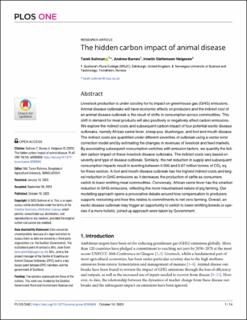| dc.contributor.author | Soliman, Tarek | |
| dc.contributor.author | Barnes, Andrew | |
| dc.contributor.author | Helgesen, Irmelin Slettemoen | |
| dc.date.accessioned | 2023-11-27T09:04:18Z | |
| dc.date.available | 2023-11-27T09:04:18Z | |
| dc.date.created | 2023-10-11T12:22:11Z | |
| dc.date.issued | 2023 | |
| dc.identifier.issn | 1932-6203 | |
| dc.identifier.uri | https://hdl.handle.net/11250/3104723 | |
| dc.description.abstract | Livestock production is under scrutiny for its impact on greenhouse gas (GHG) emissions. Animal disease outbreaks will have economic effects on producers and the indirect cost of an animal disease outbreak is the result of shifts in consumption across commodities. This shift in demand for meat products will also positively or negatively affect carbon emissions. We explore the indirect costs and subsequent carbon impact of four potential exotic disease outbreaks, namely African swine fever, sheep pox, bluetongue, and foot and mouth disease. The indirect costs are quantified under different severities of outbreak using a vector error correction model and by estimating the changes in revenues of livestock and feed markets. By associating subsequent consumption switches with emission factors, we quantify the hidden carbon impact of these livestock disease outbreaks. The indirect costs vary based on severity and type of disease outbreak. Similarly, the net reduction in supply and subsequent consumption impacts result in averting between 0.005 and 0.67 million tonnes of CO2 eq. for these sectors. A foot and mouth disease outbreak has the highest indirect costs and largest reduction in GHG emissions as it decreases the production of cattle as consumers switch to lower emitting meat commodities. Conversely, African swine fever has the smallest reduction in GHG emissions, reflecting the more industrialised nature of pig farming. Our modelling approach opens a provocative debate around how compensation to producers supports restocking and how this relates to commitments to net zero farming. Overall, an exotic disease outbreak may trigger an opportunity to switch to lower emitting breeds or species if a more holistic, joined up approach were taken by Government. | en_US |
| dc.language.iso | eng | en_US |
| dc.publisher | Public Library of Science, PLOS | en_US |
| dc.rights | Navngivelse 4.0 Internasjonal | * |
| dc.rights.uri | http://creativecommons.org/licenses/by/4.0/deed.no | * |
| dc.title | The hidden carbon impact of animal disease | en_US |
| dc.title.alternative | The hidden carbon impact of animal disease | en_US |
| dc.type | Peer reviewed | en_US |
| dc.type | Journal article | en_US |
| dc.description.version | publishedVersion | en_US |
| dc.source.volume | 18 | en_US |
| dc.source.journal | PLOS ONE | en_US |
| dc.source.issue | 10 | en_US |
| dc.identifier.doi | 10.1371/journal.pone.0292659 | |
| dc.identifier.cristin | 2183706 | |
| cristin.ispublished | true | |
| cristin.fulltext | original | |
| cristin.qualitycode | 1 | |

